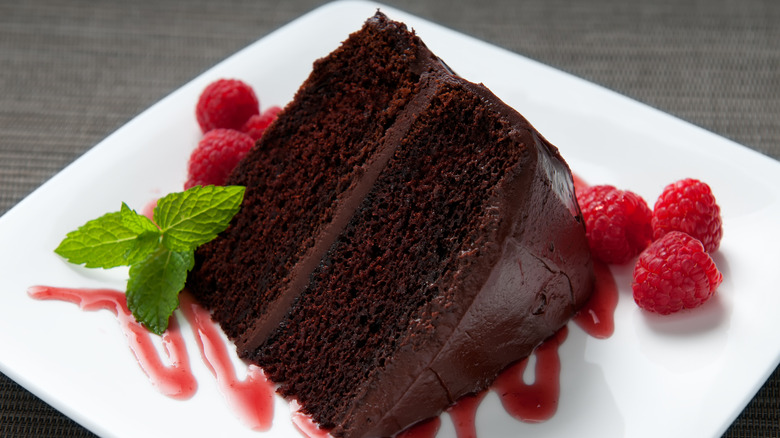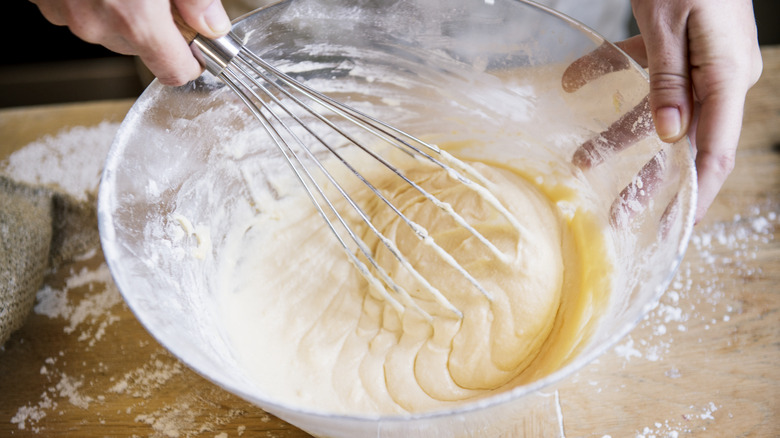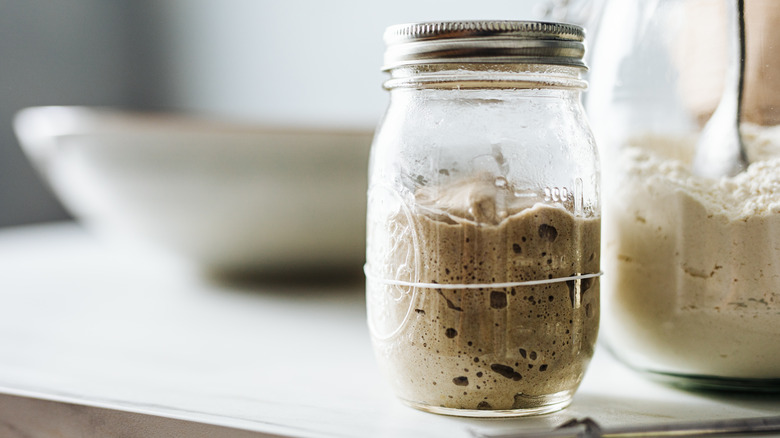Make Your Cakes Effortlessly Creamy With Sourdough Discard
While your own sourdough starter might be a few weeks old, this unique bacteria used to make tangy bread can last for literal centuries. When maintained properly, sourdough starter can last indefinitely, and there really are some batches in existence that have thrived for a hundred years. Knowing this, you might feel bad about throwing away excess starter, often called "discard" – imagine how many uses you can get out of it.
Like all living things, sourdough starters must be fed regularly, usually in a 1:1:1 ratio. That's one part starter, one part water, and one part flour. Bakers commonly "discard" some of the unfed starter so the fermenting yeast doesn't grow out of control, as it quickly multiplies in size. Throwing out the starter is a shame, as it can not only benefit bread, but also sweet treats. If you find yourself with discard on your hands, try adding it to cakes.
Sourdough discard adds acidity to batters, which benefits cakes, brownies, and muffins tremendously without adding an overt sourness. Acid inhibits excess gluten development, which gives baked goods a tender, melt-in-your-mouth texture that's almost creamy, without too much chewiness or toughness. The acid can even make your sweet treats taste better while keeping them from going stale as fast. Best of all, the discard can be used in most of your favorite cake recipes, with a few adjustments.
How to use sourdough discard in desserts
Like adding lemon juice to brighten a dish, a hint of acidity from sourdough discard enhances a cake's flavors. The discard also contains alcohol, a byproduct of fermentation, which is another flavor enhancer. Your chocolate cakes might taste more chocolatey, while fruity cakes can taste brighter. While discard makes for soft and delicious cakes, you shouldn't go crazy with it. The gluten already present in the starter is weaker, so your cakes and other baked goods will lack structure if you use too much discard and not enough fresh flour.
Start by replacing no more than ⅓ of the flour in your cake recipe with sourdough discard. The cake's flavor will benefit from the acidity without sacrificing its texture. You also probably have to reduce the liquids in the recipe (water, milk, cream, etc.). For instance, if you add ½ cup of sourdough starter to our Chantilly cake with berries recipe, reduce the amount of flour and buttermilk by ¼ cup each. If possible, use weighted measurements, which are more accurate.
Additionally, not all starters are equal, with each batching having different hydration levels. It might take a few tries to adapt your recipe to fit the discard in. If your starter isn't fed the same ratio of flour to water — for instance, you might feed it in a 1:2:2 or 1:3:3 ratio instead — the batter may end up too thick or too wet, so you'll have to adjust the ingredients.
More tips for using sourdough starter
We have a few more tips for using discard in desserts and caring for your starter. Sourdough starters mature and strengthen over time, so a new starter will be less tangy than a ten-year-old one. To balance out a mature starter's sourness, consider using discard in cakes and brownies that you plan to cover in frosting. This will balance out the tang with some sweetness. In contrast, no-bake recipes, recipes that don't use liquids, or delicate egg white-based recipes like angel food cake don't play well with discard.
Cooks who bake daily can keep a jar of sourdough starter loosely covered at room temperature, feeding it twice a day. Casual bakers may choose to store the yeast in the refrigerator, which slows its appetite so it only requires feeding once a week. Less feeding equals slower growth, which means you won't wind up with as much discard. Whether the starter is fed and used or discarded, it's essential to keep a portion called the "mother dough." This active culture will continue multiplying with regular feedings, creating more starter.
What you feed your starter with also influences its color, aroma, and consistency. Use quality, unbleached flour so the yeast has plenty to eat. Each baker has their own preference, whether it be all-purpose bread flour, pumpernickel, rye, or a combination of flours. And if you still can't repurpose all your discard, try sharing it with friends and neighbors.



